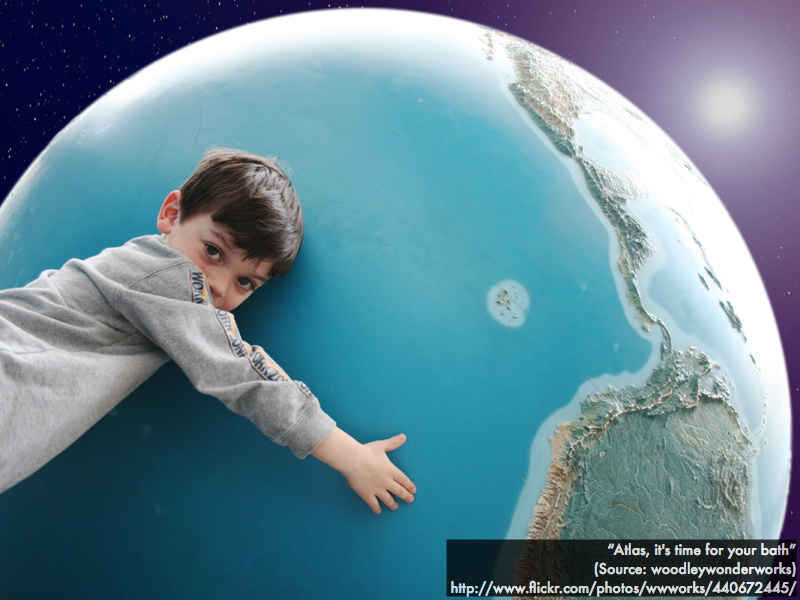Cuesta College, San Luis Obispo, CA
Students have a weekly online reading assignment (hosted by SurveyMonkey.com), where they answer questions based on reading their textbook, material covered in previous lectures, opinion questions, and/or asking (anonymous) questions or making (anonymous) comments. Full credit is given for completing the online reading assignment before next week's lecture, regardless if whether their answers are correct/incorrect. Selected results/questions/comments are addressed by the instructor at the start of the following lecture.
The following questions were asked on reading textbook chapters and previewing presentations on problems caused by the atmosphere for telescope observing, Earth, and the impacted worlds: the moon, and Mercury.
 Selected/edited responses are given below.
Selected/edited responses are given below.Describe something you found interesting from the assigned textbook reading or presentation preview, and explain why this was personally interesting for you.
"How light pollution is when particles in the air reflect both man-made and natural light, causing a faint glow and making it unable to see the night sky very well. I of course have seen the glow and never really understood why it did that."
"The analogy between viewing something from underwater and looking at stars through the atmosphere."
"Learning about the planet's surfaces. It is always interesting to learn about how they formed, why they formed and how it relates to Earth."
"Wow, this presentation was packed full of interesting new developments of the jet liner SOFIA and actively adjusting optics of lenses. I found the topic of opacity especially interesting; that certain types of light make it deeper into the atmosphere and to combat this, place telescopes on tops of mountains to better receive that kind of radiation (light)."
"I thought it was interesting how astronomers came up with the hypotheses of how the moon formed. I thought this was cool and interesting, because I have always wondered how the moon was formed."
"How the moon, while not a planet, has many similar features and formed in similar stages to planets."
Describe something you found confusing from the assigned textbook reading or presentation preview, and explain why this was personally confusing for you.
"I don't understand how atmospheric turbulence makes stars twinkle. I get that is does and the water analogy makes sense but what causes that the wind?"
"Looking up is like being at the bottom of a 'sky ocean.'"
"Adaptive optics, and how that almost completely diminishes atmosphere turbulence confusing. I just don't understand how that works."
"The large-impact hypothesis, I'm just confused on what it actually is."
"Tectonic plates."
Stars to appear to "twinkle" in the night sky because of...
"Air turbulence in Earth's atmosphere causes the distortion of our view of light."
"Rising hot and lowering cool air."
A large modern optical telescope in outer space would have images with better __________ than a comparable ground-based telescope.
brightness. *** [3] resolution. ******** [8] magnification. [2] (None of the above choices.) ** [2] (Two of the above choices.) ******* [7] (All of the above choices.) ******* [7] (Unsure/guessing/lost/help!) ** [2]
Identify how carbon dioxide enters and how it is taken out of Earth's atmosphere.
(Only correct responses shown.)
Enters atmosphere from: volcanoes [61%]
Taken out of atmosphere by: oceans [65%]
Identify the oldest (longest ago) to the youngest (most recent) features on the moon.
(Only correct responses shown.)
Craters partially filled in with flat lava plains: oldest (formed longest ago) [59%]
Flat lava plains: middle [39%]
Craters on top of flat lava plains: youngest (formed most recently) [58%]
Identify the oldest (longest ago) to the youngest (most recent) features on Mercury.
(Only correct responses shown.)
Large crater basins: oldest (formed longest ago) [74%]
Lava-filled lowlands: middle [64%]
Long curving ridges: youngest (formed most recently) [65%]
Ask the instructor an anonymous question, or make a comment. Selected questions/comments may be discussed in class.
"What Thanksgiving dish most reminds you of the moon? My answer is probably mashed potatoes, because they seem to go around the table the most number of times...so I guess it is whatever the best dish is."
"You said Earth was the most massive planet in our solar system, but there are planets in our solar system that are much bigger than Earth, such as Jupiter, Saturn, Neptune and Uranus. So is Earth more massive than all of those? I would love that explained in class, if there's time." (Earth is the most massive terrestrial ("rocky") planet in our solar system, beating out Venus, Mars, and Mercury. However, the jovian ("gaseous") planets Jupiter, Saturn, Neptune and Uranus are much larger and more massive than Earth.)
"It seems like there were a lot of iron-rich protoplanets fusing with Mercury or Earth early in the creation of the solar system. Is iron a rare commodity within the universe or solar system? Or is iron found in a lot of planets?" (Iron is a relatively rare element, but it accumulated during the planet-building process in the cores within planets.)
"How do scientists know that Mercury has a metallic core?" (From measuring Mercury's gravitational pull on orbiting spacecraft (related to how massive its core is), and measurements of its magnetic field (related to the metallic composition of its core).)


No comments:
Post a Comment